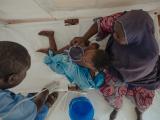Aug 29, 2003 (CIDRAP News) – After getting a green light from the Food and Drug Administration (FDA), a Salt Lake City company says it will launch the use of lactoferrin, a milk protein, as an antimicrobial treatment for beef carcasses in October.
The FDA announced last week that it sees no safety problems with the use of lactoferrin in antimicrobial sprays to prevent Escherichia coli O157:H7 contamination on beef carcasses. The agency said it has no objection to plans by aLF Ventures, Salt Lake City, to market lactoferrin for that use.
"We'll be launching this process aid beginning October 6," David R. Hall, senior vice president of aLF Ventures, told CIDRAP News. "National Beef in Kansas City [Mo.] will be placing this on 100% of their carcasses." ALF Ventures is a joint venture of Farmland National Beef, based in Kansas City, and DMV International, which is part of the Netherlands-based dairy company Campina Melkunie. Hall said Farmland National Beef accounts for about 10% of the US retail beef market.
Lactoferrin is an iron-binding protein found in milk and many other bodily secretions, according to medical reference books. In neutrophils (a type of white blood cell), it is believed to combat ingested bacteria and fungi by depriving them of iron.
Hall said the company's formulation, called activated lactoferrin (trade name Activin), doesn't kill bacteria but removes them from the surface of meat. He couldn't give a percentage reduction in bacteria effected by the lactoferrin treatment, but he said, "In the testing we did, once you put meat through the current interventions and then added lactoferrin as an incremental step, we couldn’t detect any remaining bacteria on the meat."
He cautioned, "We don't want people to say this is the silver bullet" that makes beef totally safe. "This is another incremental intervention that continues to take the pathogen level as low as it can possibly be."
Craig Hedberg, PhD, a food safety specialist at the University of Minnesota, commented that lactoferrin "serves to inhibit the growth of the organism, but there's not a lot of published literature looking at the efficacy of lactoferrin as a potential treatment. What is out there suggests that it may be in the ballpark of a 1-log [90%] reduction, which isn't a tremendous gain over other existing technologies." Hedberg is an associate professor of environmental and occupational health in the university's School of Public Health.
In a news release, the FDA said, "Although aLF Ventures was not required to seek approval from FDA before it marketed lactoferrin, aLF Ventures provided FDA scientific data supporting the firm's conclusion that lactoferrin is 'generally recognized as safe' (GRAS)." The substance is safe for the general population, including people who are allergic to milk, the statement said. A food ingredient is "GRAS" if generally available scientific data lead experts to conclude that the substance is safe for its intended use, the agency said.
In its notice to the FDA, aLF Ventures said the amount of added lactoferrin that remains on beef carcasses after spraying is comparable to the amount that occurs naturally in beef, the FDA said.
Because the residual amount is very small, the use of lactoferrin as a spray for carcasses does not require labeling of meat products from those carcasses, according to Hall and Andrea McNally, a spokeswoman for the US Department of Agriculture (USDA) Food Safety and Inspection Service. Hall said aLF Ventures earlier received approval from the FDA and USDA to market lactoferrin for other uses that would require labeling of the treated meat. "For carcass application they deem it as a process aid, so there's no labeling requirement for that," he said.
Hall said aLF is studying the use of lactoferrin as an antimicrobial treatment for "subprimal" cuts of meat (large pieces that are cut up further in retail stores), finished cuts, and ready-to-eat meats. Those uses would require labeling of the products, he said.
See also:
1994 National Institutes of Health report on in vivo activity of lactoferrin
http://grants1.nih.gov/grants/guide/rfa-files/RFA-HD-94-019.html


















